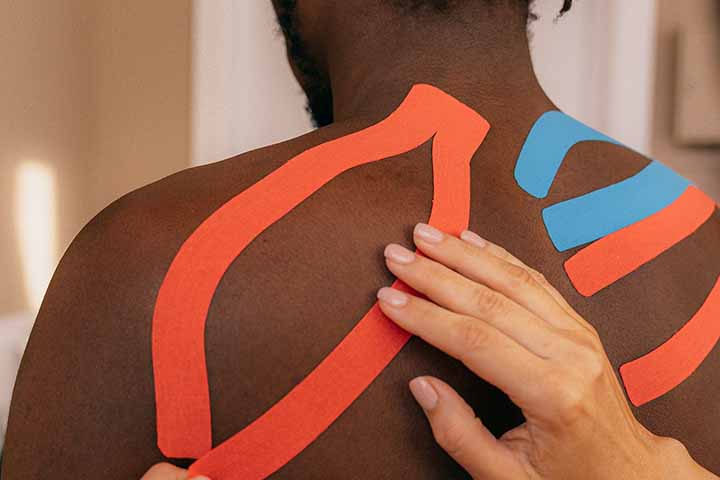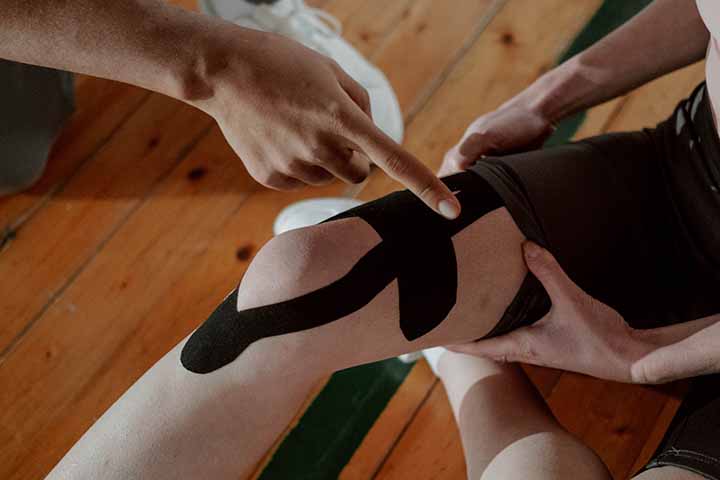I have been a physical therapist for almost 4 decades, and in our practice, we treat many orthopedic and painful conditions. One of my go-to treatment options to help patients improve is through the use of Kinesio tape, which is useful for tendonitis, shoulder pain knee pain, back pain, and neck pain (just to highlight a few).
Many of our patients wonder what Kinesio tape is, and whether or not it works.
Kinesio tape is a thin, elastic therapeutic tape used to treat sports injuries and improve athletic performance. It works by supporting muscles and joints without restricting movement, improving blood flow and reducing pain and inflammation. The tape is designed to mimic the natural properties of human skin, allowing it to be worn comfortably for extended periods of time.
I often use Kinesio tape as a part to our treatment plans. When we use Kinesio tape with patients, the question is often asked, how does Kinesio tape work? In this article I will discuss where Kinesio tape came from, the proposed mechanism of Kinesio tape influencing tissue and give examples of how I use Kinesio tape.
How does Kinesio tape work?

Though it’s not fully understood at this point, it is theorized that applying the tape to the skin helps in supplementing the lost sensory input (known as “afferent” sensory input) from injured or inflamed tissues to help the brain move more normally. This contributes to a sense of neurological stability in joints, restoring normal function.
In other words, by being attached to the skin, the colorful tape stimulates the skin’s receptors, restoring our sense of spatial awareness (called “proprioception”) around that joint. This stimulation thereby increases the amount of “afferent” information traveling thought the peripheral nerves, into the spinal cord and up to the brain.
In order to visualize how this works, imagine an old pair of socks you have. At some point, they are so stretched out they do not stay on your leg and they slide down on their own. In other words, there is no tension left in the sock.
This is similar to what happens when connective tissue is stretched beyond its elasticity limits. If there’s no tension in the ligaments, then we lose our sense of spatial awareness around that joint. At that point, there are no receptors sending afferent information to the brain with a consequence of poor movement patterns.
Unsurprisingly, this leads to all sorts of negative consequences.
Kinesio tape works by stimulating the tissues below the tape, creating the necessary afferent input to the brain to restore proper range of motion and function of the joint. By increasing the amount of afferent information, it has been suggested that we allow the muscles to work more efficiently.
A practical example
For example, let’s take the case of a shoulder injury. When stretched, there are tissues that respond, sending afferent information to the brain (Hey, I am on stretch).
These tissues are ligaments and joint capsules. This allows the central nervous system to know where the shoulder is in space and make appropriate adjustment. When you close your eyes and try to touch your nose with your finger, you are relying upon the afferent nerves to have you finger arrive close to your nose and not in your eye.
Is Kinesio tape actually effective?

We first need to define what “effective” means. The two main areas where Kinesio tape gets used is in the realm of injury rehab, as well as the realm of sports performance. We’ll discuss each here:
Kinesio tape for injury rehabilitation
One 2012 meta analysis examined studies on Kinesio tape’s effectiveness for lower extremity injury, spinal injuries, and shoulder injuries.
What most studies found was that patients who received Kinesio tape treatment experienced significant pain relief in the short term. The caveat, however, was that only the patients who participated in exercise programs got better over the long term.
This echoes what we’ve found in my many years of being a practicing physical therapist. We’re believers in Kinesio tape for helping people overcome injuries and get better – but the biggest difference maker is participation in their in-office and home exercise programs.
Kinesio tape for sports performance.
There have been several studies performed to establish if Kinesio tape “works” to improve sports performance.
Sports performance in these studies usually refers to improvements in the following characteristics: strength, speed, facilitate recovery rate, increased ROM and flexibility. Many of these studies were performed on healthy individuals.
In summary Kinesio tape has not been demonstrated to improve performance in these categories for healthy athletes. Additionally, Kinesio tape was not found to be particularly in preventing sports related injuries.
What is kinesio tape used for?
Areas that we at Petersen find Kinesio tape to be most helpful:
- Patellofemoral syndromes respond well to the support that Kinesio tape gives to the patella
- Shoulder instability
- Speeds up the time it takes to build tendon and ligament strength after an injury
- Acute ankle injuries are held by Kineiso tape giving added neurological stability as well as the tape helps with reducing swelling.
- Low back injuries
- Neck pain
- Scapula pain
- Elbow injuries
Where did Kinesio tape come from?
There are at least a few brand names of the type of tape broadly referred to as Kinesio tape. Kinesio tape is a trademarked name for this type of tape. It was originally developed by a Japanese Chiropractor in 1970.
As part of a marketing plan, Rolls of Kinesio tape were donated to 58 Olympic Teams in 2008 in Beijing China. Kinesio tape differs from the typical cloth athletic tape usually used to relieve pain in the knees, shoulders, ankles and other areas related to athletic injuries.
It is composed of cotton, having an elasticity allowing it to stretch approximately 60% of its’ original length. Kinesio tape contains a hypoallergenic glue with a very specific weave. Unlike the longitudinal fibers of athletic tape, Kinesio tape has a wave pattern weave.
I have found this type of tape under the names, KT tape and Rock Tape. In this article I will refer to all of these types Kinesio tape. (Much like facial tissue has come to be known as “Kleenex”)
How long do you leave Kinesio tape on?
The duration for which Kinesio tape should be left on depends on the purpose of the tape application and the individual’s tolerance to the tape. Generally, Kinesio tape can be worn for up to five days, but some people may need to remove it sooner due to skin irritation or discomfort. It is important to follow the instructions of your physical therapist (or other healthcare professional) when applying and removing Kinesio tape.
In Conclusion
I have seen a few treatment techniques come and go. Some fads have passed on and some have stayed. Over the years, I have developed the opinion that Kinesio tape as part of a therapy plan to treat shoulder pain, knee pain and back pain is not a fad. Kinesio tape is an effective adjunct to treatment of many ailments such as tendonitis, shoulder pain, knee pain, low back pain and other issues.
References
- Mostafavifar M, Wertz J, Borchers J. A systematic review of the effectiveness of kinesio taping for musculoskeletal injury. Phys Sportsmed. 2012 Nov;40(4):33-40. doi: 10.3810/psm.2012.11.1986. PMID: 23306413.
- Williams S, Whatman C, Hume PA, Sheerin K. Kinesio taping in treatment and prevention of sports injuries: a meta-analysis of the evidence for its effectiveness. Sports Med. 2012 Feb 1;42(2):153-64. doi: 10.2165/11594960-000000000-00000. PMID: 22124445.
- Zhong Y, Zheng C, Zheng J, Xu S. Kinesio tape reduces pain in patients with lateral epicondylitis: A meta-analysis of randomized controlled trials. Int J Surg. 2020 Apr;76:190-199. doi: 10.1016/j.ijsu.2020.02.044. Epub 2020 Mar 10. PMID: 32165280.

















